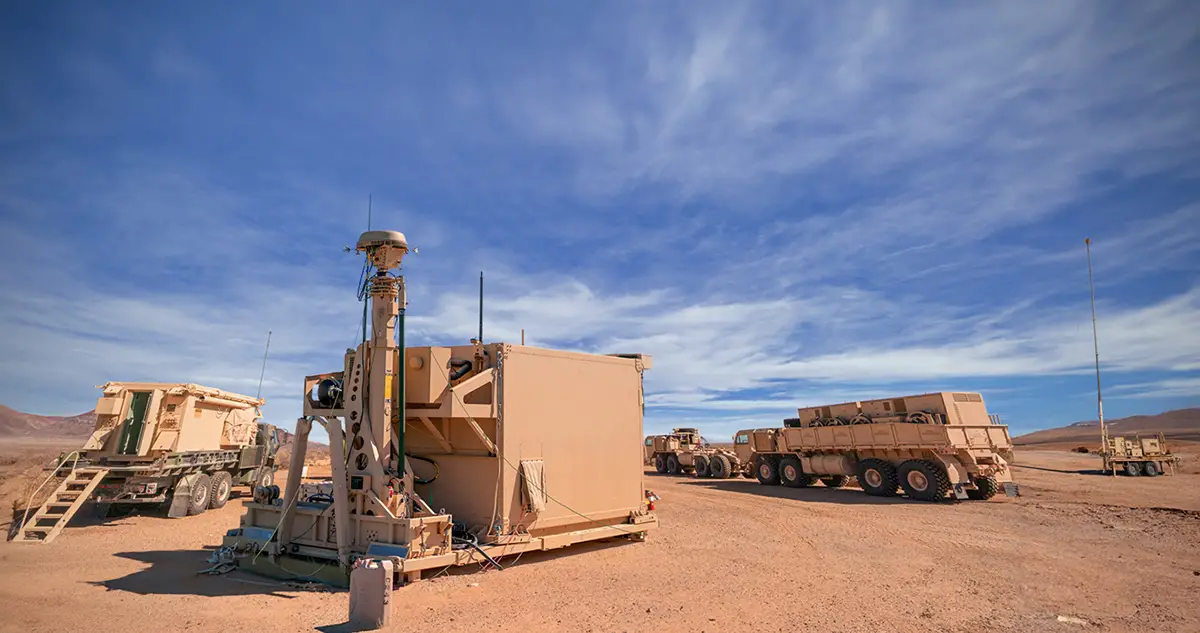Breaking news
Northrop Grumman IBCS expands battlespace during live-fire flight tests.
Northrop Grumman's Integrated Battle Command System (IBCS) continues to solidify its position as a transformational cornerstone within the U.S. Army's air and missile defense capabilities. Its recent achievement involves the successful integration of the Lower Tier Air and Missile Defense Sensor (LTAMDS), a development that signifies its ongoing significance.
Follow Army Recognition on Google News at this link

A Northrop Grumman-produced Engagement Operations Center (EOC) emplaced at White Sands Missile Range, New Mexico, during the live fire flight tests (Picture source: U.S. Army).
The months of November and December witnessed advanced live fire flight tests conducted at White Sands Missile Range, New Mexico, where IBCS once again showcased its remarkable ability to seamlessly integrate various sensors and effectors. Through this integration, the system demonstrated its prowess in fusing data from across the battlespace to effectively counter complex air and missile threats.
In these recent tests, IBCS managed to achieve several significant milestones:
• It excelled in detecting, identifying, and maintaining precise composite tracks of incoming threats, encompassing both low- and high-altitude, thanks to its adept processing of LTAMDS data.
• IBCS effectively engaged and neutralized surrogate air-breathing cruise missiles and theater ballistic missiles, showcasing its fire control capabilities, notably with the Patriot Advanced Capability – 3 system.
• Northrop Grumman's successful integration of the developmental LTAMDS sensor into the IBCS platform has substantially bolstered the system's ability to provide comprehensive battlespace awareness. Once fully deployed in 2027, the IBCS-enabled LTAMDS will replace existing Patriot radars, marking a significant advancement.
Rebecca Torzone, Vice President and General Manager of Combat Systems and Mission Readiness at Northrop Grumman, emphasized the milestone achieved by integrating LTAMDS into IBCS. She underscored the system's transformative role in reshaping the battlespace across various missions and its ability to optimize networked air and missile defense cost-effectively. Torzone reaffirmed Northrop Grumman's commitment to advancing IBCS, positioning it as a system capable of effectively countering both current and future threats.
Providing further context, IBCS is a groundbreaking command and control system designed to unify assets within the battlespace, regardless of their origin, service, or domain. Its modular, open, and scalable architecture equips warfighters with unprecedented capabilities by seamlessly integrating sensor data into a single actionable picture of the entire battlespace. This empowers rapid and informed decision-making for the optimal deployment of shooters, making IBCS a central component of the U.S. Army's modernization strategy for air and missile defense.
LTAMDS, on the other hand, represents the U.S. Army's next-generation air and missile defense radar. This active electronically scanned array radar offers superior performance against a wide range of threats, including manned and unmanned aircraft, cruise missiles, ballistic missiles, and hypersonic threats.
Northrop Grumman, as a leading global aerospace and defense technology company, remains committed to providing innovative solutions that enable customers to connect and protect the world. Their dedication to pushing the boundaries of human exploration aligns with their shared purpose of solving the toughest problems faced by their customers daily.
Defense News December 2023


























